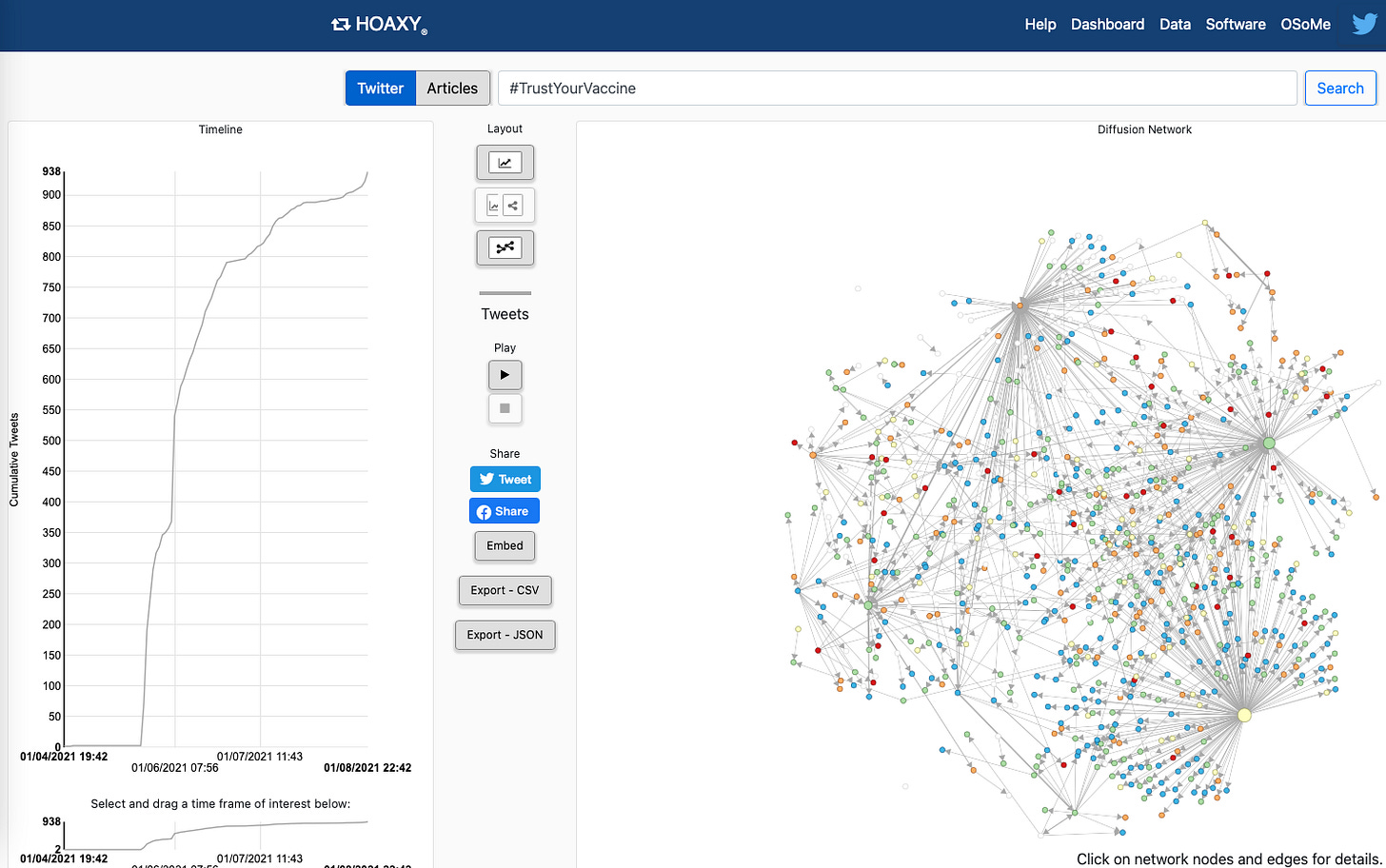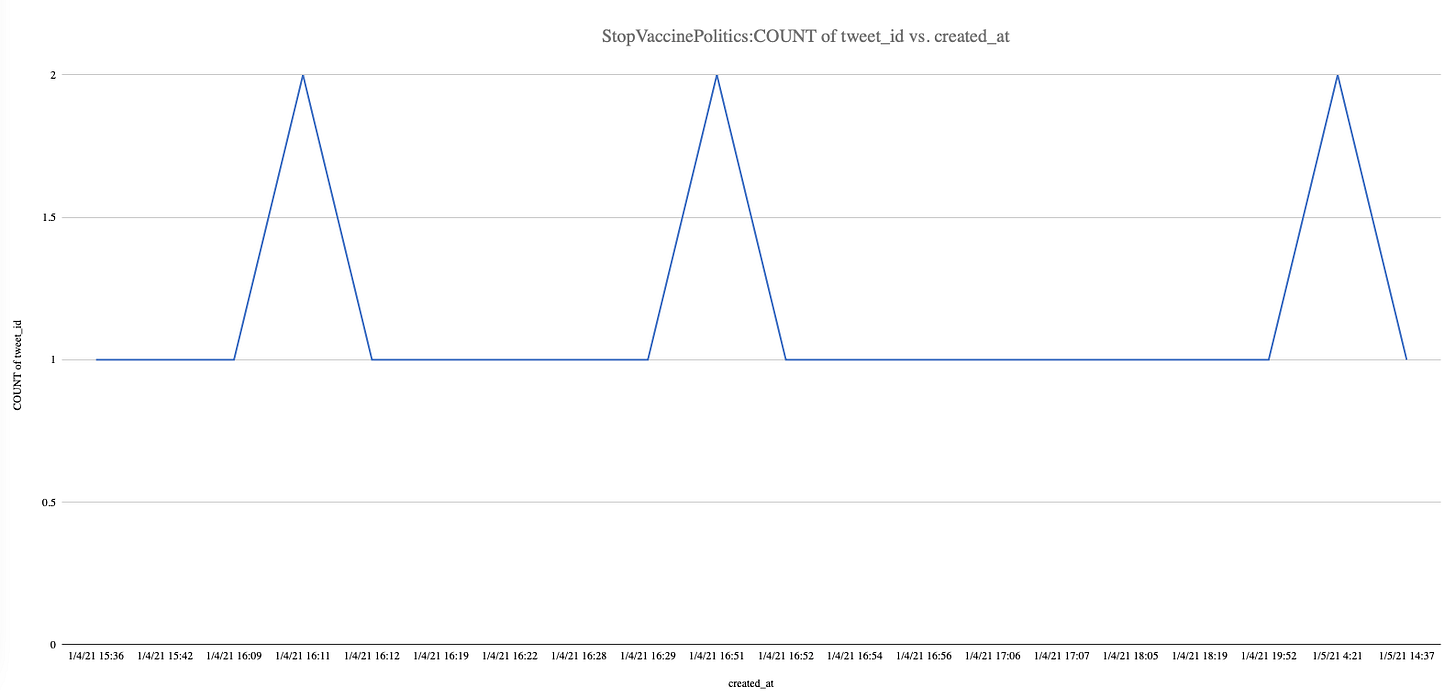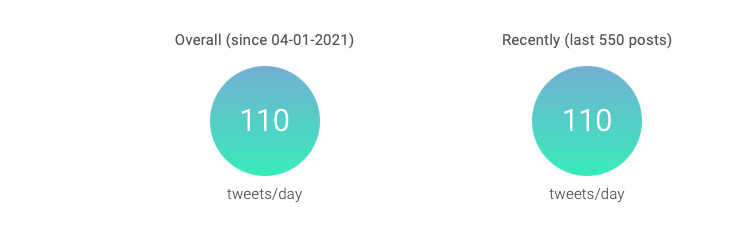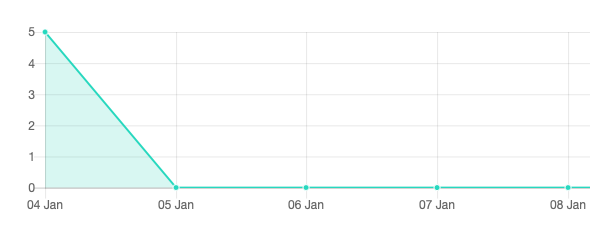What is this? This newsletter aims to track information disorder largely from an Indian perspective. It will also look at some global campaigns and research.*
What this is not? A fact-check newsletter. There are organisations like Altnews, Boomlive, etc. who already do some great work. It may feature some of their fact-checks periodically.*
Welcome to Edition 27 of MisDisMal-Information
From the writer’s keyboard: Hello, sorry, I know it has been a while since the last edition. December was not a typical month with health issues (various family members and my own keeping me away). On second thought, that was pretty typical of the year that was 2020. Anyway, some of us are doing better now, some of us aren’t. That said, let’s get to #27.
The ‘Antivaxtionals’?
In any period, 5 weeks is a long time, but in 2020 - it was both an eternity and a split second, so let me recap where I left off on the subject of vaccine-related information ecosystem.
We have a fractured information ecosystem already.
There will be questions ranging from genuine to opportunistic about the rollout process. The biggest challenge will be posing genuine questions in a way that they can neither be weaponised, nor dismissed as being in ‘bad-faith’.
Antivaxx content already exists in India. Even though it is low engagement, remember that low engagement is not necessarily the same as low effects.
The Ipsos survey pointed to existence of the belief that vaccination is not necessary.
And currently, there is a huge information vacuum, and as many experts will tell you, when that it is case that vacuum is usually filled by low quality information (intentional or unintentionally is secondary for now, though not completely irrelevant).
So it was no surprise that on the same day that Edition 26 went out, a former cricketer tweeted this:

As you would expect, he was ridiculed. But fresh off reading the Ipsos survey, I was concerned since it indicated that some people did indeed think along those lines.

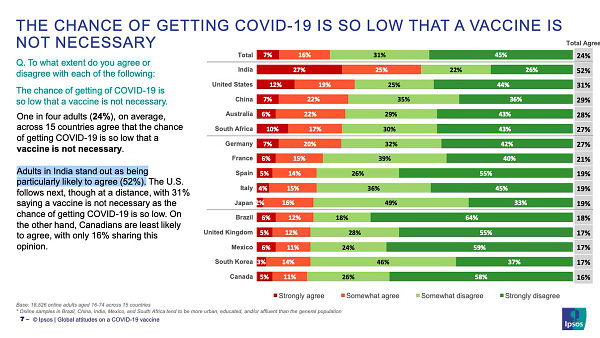
[Fun-fact: This tweet was interpreted by many as opposition to vaccines and I was given some very impolite labels🤦♂️]
But now, let’s move ahead a few days. Questions were already being raised about the approval process and people were expressing their opposition to being vaccinated. The tweets are just examples, I don’t intend to pick on or shame anyone.




.
Meanwhile, surveys by LocalCircles indicated a growth in ‘vaccine hesitancy’ - not to be confused with anti-vaccine sentiment.
Oct 23: 61% of survey respondents were either not going to rush to take it, or not take it in 2021 at all. Just 37% respondents said they would take it. ~8300 responses for this question
Dec 2: 48% respondents indicated that they would wait between 3 months to some time in 2022 to get vaccinated. ~9000 responses. Note the chart from LocalCircles itself seems to include 11% who responded as ‘Can’t say’ to get to 59% that ‘wouldn’t rush to take it’. On the press release pages, I didn’t see a clear reason attributing these to hesitancy of any sort, so I am excluding it.
Dec 18: 50% respondents indicated that they would wait between 3 months to some time in 2022 to get vaccinated. 6% said they would not get it at all ~9500 responses. Again, the LocalCircles update pegs this as 69% vaccine hesitancy including 13% ‘Can’t say’ responses.
Jan 6: 53% respondents indicated that they would wait between 3 months to some time in 2022 to get vaccinated. 9% said they wouldn’t get vaccinated at all. ~8700 responses. I have excluded the 7% ‘Can’t say’ to get to the 69% number reported on the page.
(Aside: Did anyone see any reportage questioning the inclusion of ‘Can’t say’ as hesitancy?)
Based on what we’ve seen reported by the Ipsos and LocalCircles surveys, the ‘I will not vaccinate’ sentiment is not the real pain point (yet! That shift from 0% - 6% 9% is something to watch out for though). Claims about various COVID-19 vaccines containing animal products (cows/sheep/pigs etc.) do not “seem” to have garnered a lot of attention, either. Again, I will suffix this with a ‘yet’.
I wouldn’t rest to easy on this front just yet though:
A post by Graphika in the last week of December identified a cluster of vaccine related misinformation from India. It did not, however, go into details about the nature of content (emphasis mine).
The UK groups (in yellow and purple) have the largest number of accounts participating in the vaccine conversation compared to all other countries, likely because the vaccine had already started to be distributed and administered over the timeframe of data collection. 38% of the map is made up of UK-based accounts versus the 28% made-up of US-based accounts. The other two biggest regional groups in the map are Canada and India (in light blue).
Sonam Joshi, for TOI+[potential paywall], on vaccine myths quotes Syed Nazakat founder of fact-checking platforms DataLeads and Health Analytics. This should be familiar if you are a regular reader
much of the misleading content about vaccines goes unnoticed because it is in local languages.
Currently, the biggest obstacles to a COVID-19 vaccine participation appear to be the belief that the vaccines are not necessary (Ipsos) or that people want to ‘wait and watch’. This may or not may not, overlap with an existing antivaxx position.
Neetu Chandra Sharma, for Livemint, cites a study of 351 participants in which ~86% planned to get vaccinated though that number dropped to 66% when it became a question of getting vaccinated as soon as possible.
What this should make clear is that trust will be the currency and communication will play a significant role.
[Thanks, Prateek. We already know that] Sure, but we’re still getting it wrong.
For the state, here is what not to do:
Attribute this to a single person or an initiative or indulge in vaccine nationalism.
Don’t expect ‘trust us’ to cut it.

No ad hominem attacks on those raising questions by making up terms such as ‘Antivaxtionals’ or some such inventions that play well on Whatsapp.
Think long and hard before communicating in a way solely to manage reactions/behaviour. (Oh! This is 200% safe).


For those posing questions and/or reporting on them:
As tempting and logical as it may seem, separate criticism of government(s) (union/state) on this issue from others. Whether one likes it or nor, COVID-exceptionalism is still a thing.
Situate criticism and questions on deviation from norms. For this, it also important to educate people on what the norms are - let the experts speak. Eg. In the context of approvals. What kind of data is typically released to the public, at what stage, how? What is happening in other countries? Are there factorts that make things different there?
Avoid professing publicly that ‘I will not take the vaccine’. If a sentence needs to start with ‘I am not an antivaxxer but’ - it needs work before hitting send/post.
Be very aware that the language used to raise even genuine questions, can be used to shape anti-vaccination narratives too. Example: “Oh! They are doing this with the COVID-19 vaccine which the whole world is watching, imagine what happens with ‘xyz’ vaccine which doesn’t get as much attention”.
And don’t, under any circumstances, do this:


I should point out, my aim is NOT to put the onus on those raising questions and reporting on them (I am limiting myself to the Indian context). It is to point out the importance of being responsible given the likelihood of appropriation and subsequent weaponisation of the talking points.
Brendan Nyhan, recommends considering people as belonging to one of three categories.
Those with favourable attitudes towards vaccines and actually get shots as required.
Those with mixed/marginally favourable attitudes towards vaccines.
Those with a negative view towards vaccines
The 1s will likely to get vaccinated away, moving 2s to 1s ( and simultaneously preventing them from becoming 3s) is likely where the biggest chunk of effort will need to be. That doesn’t mean 3s can be ignored because they remain part of society and can pose a risk to themselves as well as immunocompromised people. He maintains that while medical professionals will continue to be the most authoritative sources, there is a role for “well-regarded institutions, such as religious organizations, schools, businesses, and civic groups” too, in addition to celebrities.
In India, Yoga guru Baba Ramdev has spoken out in favour of the vaccine (though he couldn’t resist slipping in something about ‘immunity building’ where a commerical interest does come into play). This (and similar signalling moves) could help with the short term goal of COVID-19 vaccination, but as the face of the company behind Coronil, we must also be wary of the credibility this can bestow on him to continue speaking out on matters of public health in the future (he will speak out anyway, it is the credibility I am concerned with). And journalists who volunteered for vaccination doses and have vouched for their safety have generated controversies over whether they received placebos or not.
As we stepped into 2020’s younger twin - 2021 - approval for 2 vaccines was announced by the DCGI. Since then, we’ve had a battle of vaccine nationalism v/s vaccine rationalism. Much of the controversy has been around the type of approval granted to Bharat Biotech’s Covaxin i.e. restricted emergency use of Covaxin in emergency situation in clinical trial mode. (Have we finally figured out what exactly that means?)
As Oommen C. Kurian puts it (emphasis mine):
the Government of India on 30 December 2020 released an elaborate set of Covid-19 vaccine communication guidelines , which was welcomed by the scientific community as well-designed. However, it has been downhill since then, starting with the Subject Expert Committee’s (SEC) recommendation for emergency approvals which pointed to a distinction between Covishield and Covaxin, followed by the DCGI’s confusing approval which seemed to treat both vaccines at par.
My colleague, Dr. Shambhavi Naik explains the controversy over Covaxin data (or the lack thereof) in a way that even I understood. To summarise: the opaqueness adds to the building scepticism, vaccines from other countries that have been approved with insufficient data have also attracted questions. And, though the impact to the economy requires an vaccinations to occur at a quick pace, this cannot be at the expense of transparency of efficacy data.
Reports suggest that approval was based on immunogenicity data for 10,000 people after they have received the first dose of the vaccine and for 10,000 people after two doses. However, none of this data is available in the public domain, nor has it been peer-reviewed by independent experts. The Subject Expert Committee (SEC) made the recommendation of approval – however, very little is known about the composition of the Committee or the process followed for this approval. It will be premature to determine that Covaxin’s benefits outweigh the risks without data on its efficacy. The opaqueness of the approval process adds to the scepticism that is forming around this vaccine.
China and Russia - which approved vaccines with insufficient Phase III data – have attracted scepticism over this process. The constraints placed on the Indian economy and health crisis created by COVID-19 demand expedited approval processes; however, lack of efficacy data cannot be substituted in this fast-tracking process.
So what more information do we need? Bharat Biotech and ICMR need to demonstrate the efficacy of the vaccine through published data. Phase III trials can take time, but it will be the correct and ethical way to get the vaccine approval.
The government needs to be transparent on how approvals were given and what data were presented…. also needs to clarify the terminology used in their approval, primarily, the terms “restricted”, “abundant precaution”, and “clinical trial mode”
Now, let’s dig into some social media.
A set of twitter searches, filtered by those that have 2000 likes or more show how partisan the debate has become. I have just 2 examples here, but feel free to experiment on Twitter’s Advanced Search.
Aside: I don’t subscribe to the notion that engagement and/or reach always translates to effects, but given the current platform affordances - it is pretty much the closest we have to some sort of proxy
India, Vaccine (link)
Covaxin (link)
The hashtag that caught my attention was ‘TrustYourVaccine’. I also attempted a quick look up on hashtagify me to find related hashtags and arrived at the stopvaccinepolitics. Incidentally, both were promoted by television news channels.
Then, I put both through Hoaxy and also pulled tweets using Twitter’s Search API.
I used OSOMe’s Network Analysis tool to determine their relative engagement rates.
(Link)
I also went through my usual set of checks. It is worth noting that that the sustained high activity periods coincided - starting from 8 PM IST on 4th January and lasting a few hours.
The other interesting thing was that for both hashtags the date which on which the largest number of accounts were created was - 4th January 2021. Or, the same day as most of the engagement. There are a few caveats though. While this fact itself is worth noting - it is not the same as saying that these accounts drove a significant amount of engagement, or posted the most amount of tweets. They did not, but this pattern is worth investigating.
Whatever little activity (tweets, retweets, quotes) they did engage in, either coincided with the peaks for the hashtag or occurred just before it.
I looked further into this pool of accounts based on the following factors
Participation in both hashtags (only 4, so not much to report on this front)
Most followers gained since account creation
Most number of tweets associated with the hashtag.
One account was an outlier, with over 200 followers already.
They also posted over 200 tweets per day
And typically engaged in hashtags related to Sushant Singh Rajput
The next account with ~30 followers (quite the drop), tweets about 100 times a day.
And engages mainly with pro-Hindutva hashtags with a drizzle of Trump.
Next, for the accounts that tweeted the most from this subset.
For TrustYourVaccine, the account in question mainly retweeted Zee News’ promotion of the hashtag and has not been active since then.
While the one with the most tweets for StopVaccinePolitics seems to be an account that just indulges in hashtag-spamming
We’re now less than a week away from the scheduled commencement of India’s drive. This is likely going to continue to be politically charged. I’ll repeat, communication is key.
Don’t listen to me:
Listen to Zeynep Tufekci (including the tweet again).


Or this article in WIRED by Maryn McKenna about communication about side-effects.
Or even this pre-print by The British Academy.
Communication is therefore not passive, uni-directional, or providing detailed information on a webpage, but rather a dialogue that is participatory, iterative and sensitive to local politics.
Donald D(r)ump(f)-ed
Well, it happened. Ever since Social Media platforms took action against content by Jair Bolsonaro and then, Donald Trump - it was a question “when” not “if” - they would go to the extent of de-platforming Donald Trump. Most expected it to happen some time after January 20th, after Joe Biden was sworn in as the President of the United States. But the events of January 6th, seemingly pushed up that timeline and a number of them have now dumped Trump. *If you’re wondering why I’ve used D(r)ump(f) in this section’s title - feel free to askJohn Oliver and HBO*
Another thing they did is further cement the belief that the chasm between ‘online’ and ‘offline’ is minuscule, if not non existent. See these tweets by Kate Starbird and Renee Diresta.



Coming back to the D(r)ump(f): It isn’t just the usual suspects one expected would take action. Yes, Facebook, Twitter, Instagram, Snapchat have taken action. As Evelyn Douek points out, in many ways, this reminiscent of what happened with Alex Jones, when many platforms acted in quick succession - like ‘falling dominoes’.



As per this Axios by Sara Fischer and Ashley Gold, so far it is :
Reddit: r/DonaldTrump
Twitch: Trump’s Twitch channel
Shopify: ‘two online stores affiliated with Trump’
Twitter: Trump’s account
Google: Removed Parler from the Play Store
YouTube: More enforcement
Facebook: 2 week ban for Trump
Instagram: 2 week ban for Trump
Snapchat: Trump’s Snapchat account
TikTok: certain hashtags
Apple: Gave Parler 24 hours to devise a content moderation strategy (ok, then!), and then pulled it from the App Store.
Discord: ‘banned server The Donald’
Pinterest: limiting specific hashtags
(The article lists context as well, I do recommend reading it)
This is likely to change by the time I schedule this and/or when you read it. Just look at the Techmeme page tracking this: it is dissertation level-stuff.
We already know that Amazon has decided to pull AWS services from Parler.
As I was saying, dominoes, er..sort off:
Ok, let’s break this down into 2 parts
Social Media Platforms (public square and public goods or just a large public gathering in a private space and club goods?)
As I said, this was a question of when and not if, as social media platforms got more and more interventionist in 2020. There are legitimate questions (some of them have been around for years if you are following this closely, of course) - I won’t retread that ground.
Ok, maybe a just a little. We’ve all heard the comparisons to a ‘public square’ and the comparisons to de-platforming as ‘censorship’. Over the years, I’ve found this ‘public square’ framing harder to digest simply because of the way things currently work. Platforms in their current form fit the model of a ‘large public gathering’ in a private space (or even a ‘club’) more closely whether you consider governance, maintenance, enforcement or any other aspect. This may or may not be the right model to foster a healthy information ecosystem (experience suggests that it likely isn’t) but one thing it does, is give platforms some level control over who/what can be posted/shared (“We reserve the right to refuse you service etc”).
Yes, that should make us uncomfortable. But we’d we well advised to remember that the task of fixing the information ecology goes beyond just platforms.

What to expect when you’re de-platforming:
Now that it has been done, social media platforms have made things a lot more difficult for themselves. And though one would expect that the logical thing to do would be more transparency about such decisions (and there will be more) in the future. Instead, what we are likely to get is even more inconsistent policy application and hard to digest post-facto justifications. Aside: One of my favourite pieces on this is by Evelyn Douek in The Atlantic.
There is already a chorus of voices pointing out that political leaders have used platforms to similar (if not worse) effect in other countries, that should have been liable for similar action using the same yardstick (in this case, policies)

These will likely divide themselves along the lines of “FoE” “Censorship” v/s Hate or Dangerous speech. On Indian Twitter, we’ve already had competing hashtag campaigns over permanent suspensions for Kapil Mishra. Right leaning figures are calling more regulation of the ‘Foreign’ ‘Big Tech’ platforms, potentially an attempt to pre-empt action.

Thanks to good old group dynamics, people will offer-up ‘opponents’ whose accounts they believe should meet a similar fate. And no matter what platforms decide to do/not to - the information ecosystem will continue to be polluted.


If you want to poke around more, I also attempted to use Twitter’s advanced search to catch more such tweets. [Link]
I am going to plug some older research that my colleague Rohan Seth and I put out back in June on social media platform responses to COVID-19 specific information disorder. We expected more interventionist platforms to not only effect the interactions between states, platforms and societies - but we also expected that they would increase competition in between states, platforms and societies when it came to platform intervention. Eg. GlobalTimes managed to take a dig on US’ “moral high ground” . These trends are already in effect and will only accelerate with these actions.
The Content Moderation Stack
CloudFlare’s decision to de-platform Daily Stormer in 2017 and 8chan in 2019 were significant (disclosure: I worked at a competitor of Cloudflare from 2011 to 2019). Typically, at that level in the ‘stack’, you have an acceptable-use policy where you decide whether to take on a company’s business or not - but there is generally little-to-none active moderation (China being an exception) once they are on (I am excluding ‘services’ they may offer such as Ddos protection or Web Application Firewalls. Keyword filtering falls into an undefined bucket for now, since the keywords are defined by the companies that avail these services).
That is, obviously, changing and no longer seems to be enough. Keep in mind though, that if we accept that social media platforms function like ‘clubs’ (this is statement on what they are like, not how they should be. i.e. positive, not normative) - companies deeper in the stack are arguably even more exclusive clubs - because of who the customers are (mostly, other paying corporations).
From edition 16
Suzanne van Geuns and Corinne Cath-Spethtalk about Cloudflare’s decision to de-platform DailyStormer and 8chan because of their hate-filled content to raise the question : What is the political process behind their content moderation decisions?
Thinking of a company like Cloudflare as an internet sheriff is especially ironic given the increasingly common comparison between the internet and public utilities. When the pandemic shifted education, work, and social life online, the need for working internet infrastructures became acute enough to make it feel like an essential good.
The same paragraph goes on to further justify the public utility concept
One of these self-congratulatory posts remarks that it is “hard to imagine another utility (say electricity, water or gas) coping with a sudden and continuous increase in demand of 50%.” In this light, the company’s “mere conduits” transport an essential good, and Cloudflare is an indispensable public utility service.
In October 2019, Joan Donovan wrote (she even lays out the kind of moderation that should happen at each level of the stack):
At every level of the tech stack, corporations are placed in positions to make value judgments regarding the legitimacy of content, including who should have access, and when and how. In the case of 8chan and the rash of premeditated violence, it is not enough to wait for a service provider, such as Cloudflare, to determine when a line is crossed. Unfortunately, in this moment, a corporate denial of service is the only option for dismantling extremist and white supremacist communication infrastructure.
In an Internet Policy Review article Tarleton Gillespie says this about cloud computing services and moderation at many points along the infrastructure stack:
Cloud computing services also moderate, not by removing particular bits of content, but by rejecting whole sites or entire platforms. Typically, services like Amazon Web Services or Microsoft Azure claim a position of neutrality, preferring not to be in the business of picking and choosing, drawing on the protections of Section 230 of the Communication Decency Act (CDA 230) and the sensibility of net neutrality enjoyed by ISPs. At the same time they reserve the right, in their terms of service or contractual agreements, to drop any client for a wide range of reasons.
He also adds that if policies along the stack align - whoever experiences deplatforming will experience it “to a much deeper degree”. But most significantly, that this moderation is “harder to see or hold accountable”.
Pranesh Prakash paints an extreme picture.


Today, it so happens that the exercise of this ‘infrastructural moderation’ is for a “cause” in support of democracy that many can get behind. But, we’ve seen in other countries, this ‘discretion’ has also been used against such causes - if you recall Apple removing HKmap.live (I am tempted to include ISPs complying with internet suspension orders in this lot too - but it is open to debate whether than can be considered ‘moderation’ in the sense that action is selective).
If these corporate denials of service (to borrow the term used in Joan Donovan’s article) are going to be a feature of the future - then we need to expand our demands for consistent moderation beyond just social media platforms. This is easier said than done, when we haven’t really arrived at an agreed set of principles even for ‘visible’ content moderation. ‘Invisible’ or ‘less visible’ enforcement is even harder. More transparency? Sure, that’s a start - but only a start.









